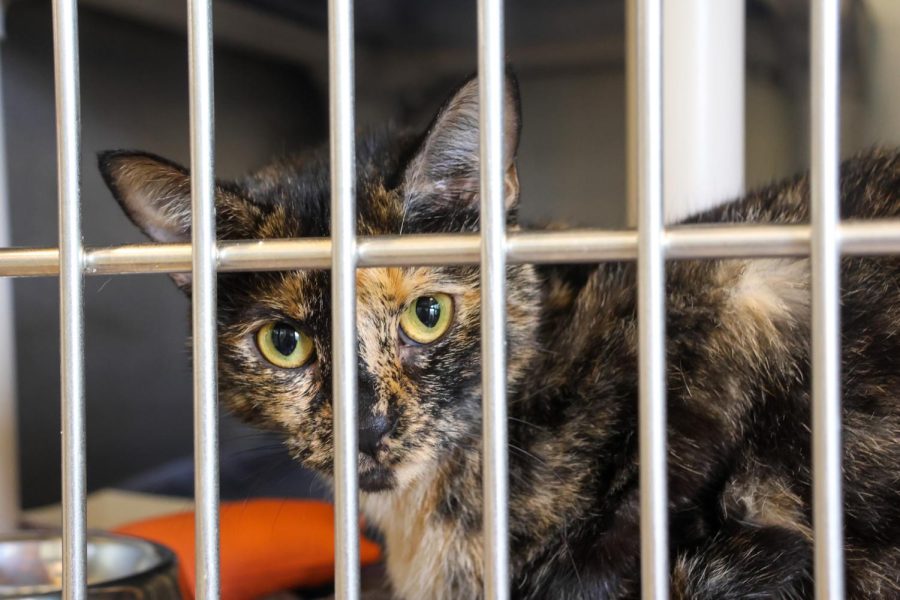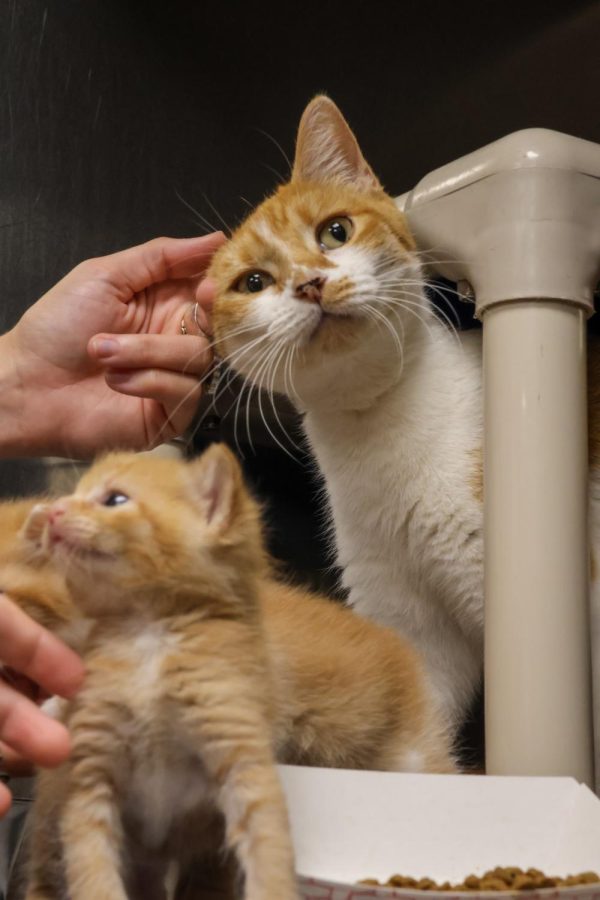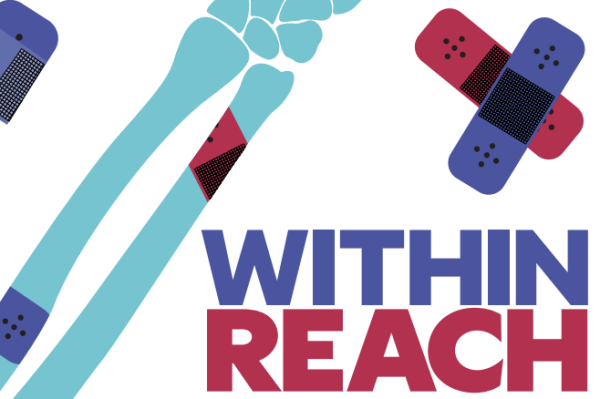Overflowed
After extreme floods hit the state, Louisville’s Kentucky Humane Society tackles the struggles that come with overcrowding. Writing by Sammie Haden and Maya O’Dell | Design by Jazmine Martinez | Photos by Jazmine Martinez and Victoria Long
Photos by Jazmine Martinez
Looking Through the Bars: A cat located at the Kentucky Humane Society’s main campus stares at the camera through the bars of its cage.
The walls were lined with crates, and the sound of wagging tails hitting the tile floor filled the room. In our peripheral vision, we saw paws pressing against the gates of kennels, desperately reaching out to us. Every kennel but one. We stopped in front of the silent crate and found an older dog, with a pair of gray ears slowly perking up at the sight of new faces. I reached out two fingers to her, an invitation she timidly accepted. As I stepped back, I caught a glimpse of the sign displayed on the front of her crate: “AURORA — FLOOD DOG.”
Even after we left, our interaction with Aurora stuck out in my mind. All of the other dogs we met in Louisville’s Sam Swope Pet TLC Kentucky Humane Society (KHS) jumped up onto newcomers and barked out loud greetings, eager to come home with these new people. So why was Aurora different? Suddenly, we realized why: this dog already has a home. She’s not looking for someone else to take her in — she’s hoping to find a way back.
In late July, Eastern Kentucky was hit by record-breaking floods. Kentucky residents from all around followed the news, watching the damage unfold and keeping the victims in their thoughts and prayers. Others donated supplies or money to the people hit by the floods. With thirteen counties affected, the citizens of Eastern Kentucky needed all the help they could get.
But a smaller story was also being told amidst the tragedy.
Over 100 animals were displaced due to the floods. Aside from the outpour of love and support from civilians, Louisville’s main KHS campus went straight into crisis mode to help control the overflow of displaced dogs and cats.
“We work with the rural shelters already,” Victoria Long, the community relations manager for the KHS, said. “I call them our sister shelter. We’ve done thousands of transports with them; we have relationships. So if they’re hit, we’re hit.”
Long, and many other KHS employees, spent days transporting animals from Eastern Kentucky to Louisville.
“I went on all three transports there. And it’s pretty incredible,” she said. “It’s nice to see that shelter slowly get emptier and emptier and emptier each week. It was really rewarding — tough, but very rewarding.”
Overcrowding has always been an issue in animal shelters. While the reasons are varied and inconsistent, the massive influx of pets always stays high.
According to the American Society for the Prevention of Cruelty to Animals (ASPCA), 6.3 million animals enter animal shelters every year.
“It’s a problem for all shelters everywhere. It’s a nationwide issue,” Long said.
While overcrowding is a problem, animal shelters have come to expect it and are used to handling a large number of animals. But when disaster strikes a community, a wrench is thrown into this normalcy — and disasters can vary across the country. In California, it could be from displacement after a fire. In Florida, overcrowding could come from a hurricane. But what makes Kentucky’s overcrowding unique?
Kentucky has faced new challenges in recent years. The flooding was a tragedy for the people living in the affected Eastern counties. Eastern Kentucky had dealt with some droughts preceding the flood, and with the seriousness of the storm, the soil couldn’t soak up the excess water. People unaffected by the floods offered their support to help deal with the damages. Some started cleanup crews to attempt to start to restore homes, while others donated to help fund whatever the citizens needed after the tragedy. But despite their efforts, with a death toll of 43 and houses and business fronts destroyed, the number of animals being sent to Louisville’s main and east KHS campuses drastically increased.
“When there is a natural emergency like this, we focus on clearing out the shelters of the animals they already had prior to that storm, or whatever emergency at that time,” Long explained.
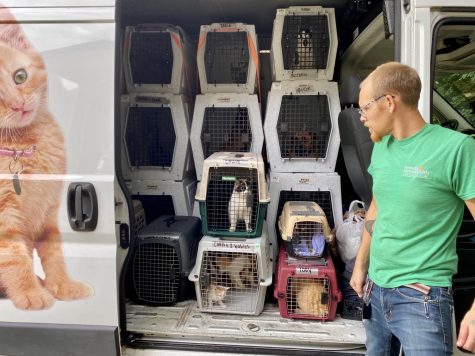
If shelters are already at carrying capacity — if not over — taking on so many animals at once is a difficult feat. The KHS ended up taking in an unprecedented amount of displaced animals in the aftermath of the flooding.
Although the flooding was detrimental, overcrowding isn’t just a result of disasters. There are many other reasons shelters can become and remain overcrowded in the long-term.
According to the American Kennel Club (AKC), an organization dedicated to the prevention and treatment of diseases in all dogs, over 80% of all dogs are spayed and neutered, as well as an approximate 85% of cats. However, the remaining percent can, 9 times out of 10, cause unexpected pregnancies in animals that the owner wasn’t prepared for. This often leads to the owner sending the baby animals to a shelter because they can’t handle all of them. Things as simple as spaying and neutering pets to prevent accidental pregnancies could make a big impact.
“We have our SNIP clinic that combats spay-neuter populations,” Long said. “We have our SNIP clinic, our pet helpline — which is available for anyone in the community if they need aid or need a bed voucher, or just advice.”
“That’s here for them, as well as a pet food bank, every week, Thursday, one to three, when we have food.”
The SNIP clinic lets dogs and cats get spay or neuter procedures, which are cheaper than average if the owner gets them done through the KHS. They also have several vaccines and payment aids that the animals could be eligible for.
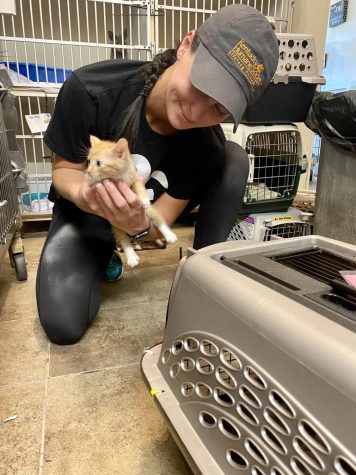
Another major contributor to overcrowding is breeding, the process of mating animals to provide litters of puppies or kittens of a desired breed. Breeders create puppy mills, which produce over a million puppies per year. Since breeding is a private business, animal deaths during the breeding process aren’t reported. There are over 10,000 puppy mills in the U.S., but only around 3,000 of them are regulated. These mills are so successful because people often prefer the “newer and shinier” models of animals, and many times, the baby animals find homes quickly. However, the ones that aren’t immediately adopted are sent to shelters. These new animals add up quickly with the large number of puppies and kittens being bred a year, increasing the severity of shelter overcrowding.
Among the reasons for overcrowding, many people think that COVID animals have caused serious problems.
“COVID animal” is a term for pets that became popular when COVID-19 was spreading in 2020. During lockdowns, people had an increase of time on their hands, and pet adoption skyrocketed. 23 million households decided to get a pet during this time, but when things started to pick back up, taking care of a new pet became too much for owners to handle, leading to many animals being returned to shelters. However, COVID animals make up only a small percentage of why shelters have had to welcome returned or given-up pets.
“I know some people think that we’re having issues with COVID animals being returned. That is not the only answer,” Eugenia Scoggins, the volunteer engagement manager at KHS, said.
Instead, breeding and disasters cause more dire and consistent overcrowding.
If there’s an extreme lack of space, it’s not uncommon for shelters to euthanize animals. This is a very controversial method, and the Kentucky Humane Society is among those that strive to never euthanize animals. However, this means that the shelter has more animals to take care of.
One of the biggest ways the KHS is able to manage overcrowding is through their volunteer program.
Volunteers can help out as early as age 14, and the KHS encourages Louisvillians to sign up, especially after the flooding. Even though the help provided through volunteering doesn’t calm the massive influx of animals, it helps ensure that all pets are getting the best treatment possible.
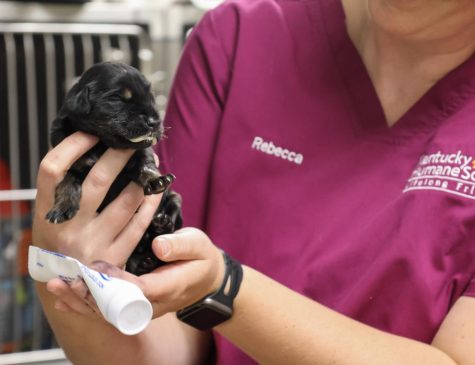
Volunteers fold letters, clean, do laundry, transport animals, pick up donations — there’s a job for everyone. As a result, becoming a volunteer is relatively simple.
“The actual volunteer orientation on-site includes a bit about what volunteers get from volunteering with KHS, what KHS gains from volunteer help, and volunteer expectations. Then a tour and some training on cleaning tasks around the shelter,” Scoggins said.
Not every volunteer opportunity is on-site, either. The “Date with a Dog” program allows the dogs to leave the shelter and have some fun, then come back refreshed. While this is only for people older than 18, Scoggins added that many youth volunteers look forward to this opportunity.
The KHS website has examples of volunteers. 24-year-old Zoë Slaughter is the perfect example of a youth volunteer. When Zoë was in high school, she used to volunteer at the Steedly Drive campus and walk the senior dogs, according to a blog from the KHS website. She still volunteers and now, as an adult, has a dog of her own. The KHS hopes volunteer numbers continue to grow in order to help all of the animals that may enter their shelters.
“Beginning the volunteer journey at a young age is a great thing to watch,” Scoggins said. “We really do build a relationship here through our care for animals and as people. It’s extra special to watch that love grow as some of these kids grow up.”
All volunteers are expected to follow directions and be respectful toward all animals. Volunteers will work with and without supervision, it just depends on the animal and what activity they are participating in.
For the Louisville youth who are too young to volunteer, but still want to get involved, the KHS allows children 13 and under to do At-Home Pet Projects. These projects include creating toys for the animals, hosting a Wish List Drive — which is when the KHS makes wish lists for the animals and collects donations from the community — and so much more.
Many young, aspiring volunteers have already taken advantage of the volunteer program. Among them is 16-year-old Sydney Barnes, who is a student at Ballard that participates as a volunteer through her Girl Scout troop.
“The whole experience is very relaxed,” Barnes said. “Me and my friends spent a few hours baking dog treats for the animals. It was a really fun experience, and the staff really made the environment friendly and welcoming.”
Volunteering leads to fewer animals not receiving proper care. However, it isn’t an option for some. Fortunately, there are many other ways that Louivillians can combat overcrowding.
Some people prefer fostering over adopting because it’s more convenient for their lifestyle. Apartments, short-term living arrangements, not enough money, and trying out pet ownership temporarily are just a few reasons why some foster animals. Many dogs are fostered too young to get spayed or neutered, or they are recovering from a surgery or illness. If one fosters through KHS, they provide all the needed materials: food, leash, collar, and crate. The foster, on average, would only watch the dog for two weeks, but fostering can also last for just a few days to as long as a few months.
“Fostering saves lives,” Long said. “Because we had such an influx of animals out of Eastern Kentucky, we didn’t have space in the shelter. We took them from the rural shelters and immediately put them into foster families. So that’s just a huge help.”
The KHS currently has around 500 fosters in their foster department, and about one-third of all of their shelter animals go through the foster system.
While it may be a cliche, the saying, “a man’s best friend,” holds strong within the KHS. Even with the overflow of love and support that has helped countless amounts of animals, there is always more that has to be done. By volunteering, spay-neutering pets, stopping excessive breeding, and just by becoming educated on overcrowding, there will be many more happy animals in loving homes. Even though these animals are coming in at constant rates, our community can ease this stress when everyone pitches in.
Donations are collected through The Publishers, duPont Manual High School's booster club for J&C. On The Record relies completely on sponsorships, advertisements, and donations to produce and distribute each issue. Please consider donating to our cause, and helping the student journalists of OTR amplify youth voices for years to come.

Maya O’Dell is a senior and this year’s print managing editor. She is a third year staffer and is excited to help expand OTR’s presence. She enjoys...

Sammie Haden is a third year staffer and this year’s EIC! Her favorite story she has written is Taking Center Stage and she is excited to work with her...

Jazmine Martinez is a senior and the Design Editor for On The Record. This is her second year on staff and she is excited to continue exploring her creativity...



